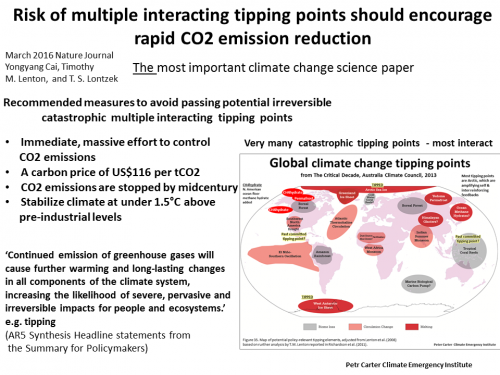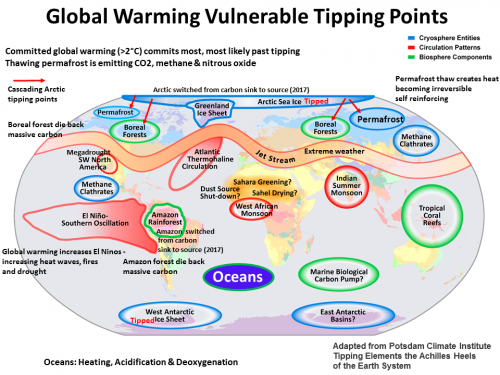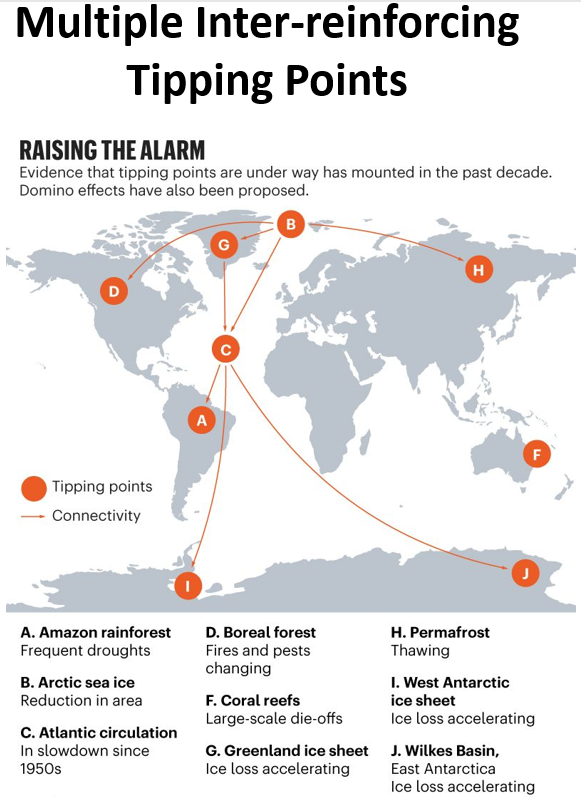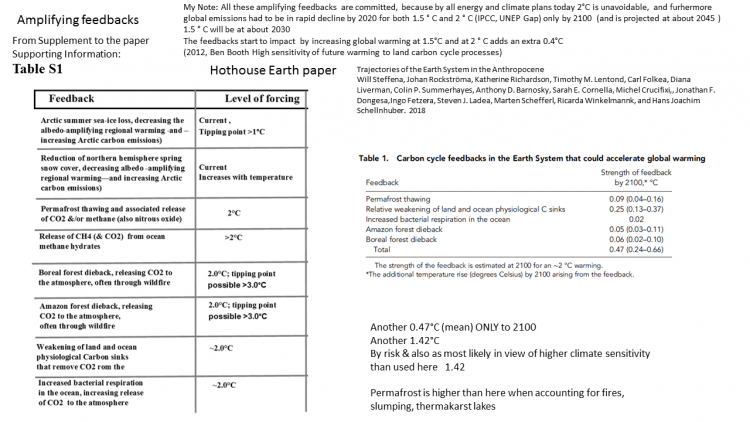Tipping Points
Not new sceince
Tipping elements in the Earth's climate system Timothy M. Lenton et al PNAS Feb 2008
Tipping elements in the Earth's climate system Timothy M. Lenton et al PNAS Feb 2008
What are tipping points?
The term ‘‘tipping point’’ commonly refers to a critical threshold at which a tiny perturbation can qualitatively alter the state of a system (T. Lenton). This generally includes an abrupt irreversible climate system switch and an acceleration of change beyond the driving forcing (NAP 2011) (NRC 2011 Summary).
The term ‘‘tipping point’’ commonly refers to a critical threshold at which a tiny perturbation can qualitatively alter the state of a system (T. Lenton). This generally includes an abrupt irreversible climate system switch and an acceleration of change beyond the driving forcing (NAP 2011) (NRC 2011 Summary).
James Hansen on tipping points years ago lecture (2009).
"Here are several climate tipping points of special concern. Tipping points are “non-linear” phenomena, which means that they can reach a point at which rapid catastrophic change occurs.
Species extermination is also a non-linear problem. Today we are placing many species under multiple stresses, but one stress that is growing rapidly is the shifting of climate zones due to global warming. ... Because of interdependencies of species, the loss of key species can cause entire ecosystems to collapse.
Arctic methane. Methane is an especially powerful greenhouse gas. There are large amounts of methane presently locked up, frozen, in high latitude tundra and, especially, in ocean sediments on continental shelves. We know from Earth’s history that this frozen methane can be released suddenly by sufficient warming – thus this methane has the potential to greatly amplify human made
global warming, if that warming reaches a level, a tipping point, such that large volumes of frozen methane begin to melt."
It is intuitive that there won't be early warnings and even if there jt would far too late to stop or slow the the boosted warming.
A 2010 study on tipping points: Early warning and wishful thinking finds that they have very limited predictability. The worst tipping point would be an abrupt large increase in global temperature. This paper takes the ice core abrupt warming events and finds no early warning indicators.
Like James Hansen, Andrew Gliskson finds from the ice core distant past that the planet tends to warm abruptly and we have added too much GHG heat to the system for any security of avoiding tipping points. Trends and tipping point in the climate system: portents for the 21st century. Past and current trends in the atmosphere/ocean system Andrew Glikson Earth and Palaeoclimate science Australian National University.
The Australia government office for science has background paper Dangerous Climate Change and Tipping Points includes a list of potential tipping points:
• rapid melting of the Greenland Ice Sheet
• collapse of the West Antarctic Ice Sheet
• abrupt retreat of Arctic summer sea-ice
• shut-down of the over-turning circulation in the Atlantic Ocean – also known as the ‘Atlantic Meridional Overturning Circulation’ (AMOC) or the Atlantic Thermohaline Circulation
• dieback of the Amazon rainforest
• rapid release of methane from permafrost or ‘methane hydrates’. Methane hydrates are structures consisting of methane locked into a water-ice lattice. They are sometimes referred to as ‘methane clathrates’. They occur in deep ocean sediments and under permafrost (frozen ground)
• sudden changes to marine ecosystems resulting from ocean acidification
What has been little attention is the possibility of self reinforcing +ve feedbacks or multiple cascading catastrophes reaching planetary tipping levels for a megacatastrophe. A Harvard discussion paper Responding to Threats of Climate Change Mega- Catastrophes does consider and how to respond to such a risk. This addresses the important question of rapid abatement and geo-engineering.
As there are many potential tipping and they inter-reinforcing risks for a planetary catastrophe this alone argues for the development of the rapid planetary emergency response capacity.
"Here are several climate tipping points of special concern. Tipping points are “non-linear” phenomena, which means that they can reach a point at which rapid catastrophic change occurs.
Species extermination is also a non-linear problem. Today we are placing many species under multiple stresses, but one stress that is growing rapidly is the shifting of climate zones due to global warming. ... Because of interdependencies of species, the loss of key species can cause entire ecosystems to collapse.
Arctic methane. Methane is an especially powerful greenhouse gas. There are large amounts of methane presently locked up, frozen, in high latitude tundra and, especially, in ocean sediments on continental shelves. We know from Earth’s history that this frozen methane can be released suddenly by sufficient warming – thus this methane has the potential to greatly amplify human made
global warming, if that warming reaches a level, a tipping point, such that large volumes of frozen methane begin to melt."
It is intuitive that there won't be early warnings and even if there jt would far too late to stop or slow the the boosted warming.
A 2010 study on tipping points: Early warning and wishful thinking finds that they have very limited predictability. The worst tipping point would be an abrupt large increase in global temperature. This paper takes the ice core abrupt warming events and finds no early warning indicators.
Like James Hansen, Andrew Gliskson finds from the ice core distant past that the planet tends to warm abruptly and we have added too much GHG heat to the system for any security of avoiding tipping points. Trends and tipping point in the climate system: portents for the 21st century. Past and current trends in the atmosphere/ocean system Andrew Glikson Earth and Palaeoclimate science Australian National University.
The Australia government office for science has background paper Dangerous Climate Change and Tipping Points includes a list of potential tipping points:
• rapid melting of the Greenland Ice Sheet
• collapse of the West Antarctic Ice Sheet
• abrupt retreat of Arctic summer sea-ice
• shut-down of the over-turning circulation in the Atlantic Ocean – also known as the ‘Atlantic Meridional Overturning Circulation’ (AMOC) or the Atlantic Thermohaline Circulation
• dieback of the Amazon rainforest
• rapid release of methane from permafrost or ‘methane hydrates’. Methane hydrates are structures consisting of methane locked into a water-ice lattice. They are sometimes referred to as ‘methane clathrates’. They occur in deep ocean sediments and under permafrost (frozen ground)
• sudden changes to marine ecosystems resulting from ocean acidification
What has been little attention is the possibility of self reinforcing +ve feedbacks or multiple cascading catastrophes reaching planetary tipping levels for a megacatastrophe. A Harvard discussion paper Responding to Threats of Climate Change Mega- Catastrophes does consider and how to respond to such a risk. This addresses the important question of rapid abatement and geo-engineering.
As there are many potential tipping and they inter-reinforcing risks for a planetary catastrophe this alone argues for the development of the rapid planetary emergency response capacity.
The ultimate tipping point caused by industrial GHG global warming would be so-called 'runaway' global warming/ rapid global warming, abrupt global change, irreversible global climate change, in the science terms. This is a self accelerating multiple amplifying (mainly Arctic) feedback situation. Research published on 30 July 2013 suggests that this could happen.
21 March 2016. Nature. Risk of multiple interacting tipping points should encourage rapid CO2 emission reduction. Yongyang Cai, Tim M. Lenton, T. S. Lontzek

VIDEO 2013 Earth may reach tipping point Prof A. Barnosky
23 June 2017 Tipping points are real: Gradual changes in carbon dioxide levels can induce abrupt climate changes (abrupt extreme N.H. warming)

Climate tipping points —too risky to bet against, Nature, Nov 2019,
In our view, the evidence from tipping points alone suggests that we are in a state of planetary emergency...
We argue that the intervention time left to prevent tipping could already have shrunk
towards zero, ...In other words, warming must be limited to 1.5 °C. This requires an emergency response."

Feb 10th 2020 Carbon Brief Article: 9 ‘tipping points’ that could be triggered by climate change
Exceeding 1.5°C global warming could trigger multiple climate tipping points
'Hothouse Earth' tipping point paper, August 2018, Trajectories of the Earth System in the Anthropocene

Youtube 2021 Climate expert Johan Rockström Explains Earth's Climate Tipping Points

Multiple large global warming feedbacks triggered at 2°C (or less) 2018 'hothouse Earth' paper
